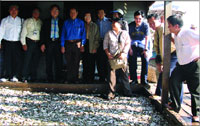Shared lessons from the inland fisheries

High-level representatives from the
Thai and Cambodian Departments
of Fisheries shared their knowledge
on the field trip.
Inter-country cooperation is the cornerstone of the Mekong Agreement, but before such cooperation can have practical applications it is important for those making decisions to see what’s going on in the field. It is not always easy to make a high level decision on regional issues when based in a city and often the expertise needed is not even available in the same country.
It was with these issues in mind, that a delegation of senior fisheries experts and scientists from the Department of Fisheries in Thailand, headed by Director General Dr Sitdhi Boonyaratpalin, went to learn first-hand how their counterparts in Cambodia were managing their very productive inland fisheries.
The January 2005 trip, which was organised and funded by the MRC Fisheries Programme, was hosted by the Inland Fisheries and Research Development Institute (IFReDI) of Cambodia and provided the Thai group with their first, close-up look at the inland fisheries of Cambodia, the basin’s most prolific fish producing area.
The inland fishery in Cambodia is conservatively estimated at more than 400,000 tonnes per year, with catches of other aquatic animals totalling at least 60,000 tonnes and it is among the largest and most significant inland fisheries in the world.
The idea was to absorb some lessons from the success of these inland fisheries and transpose them to the inland fisheries of North East Thailand in order to boost their productivity.
The Cambodian delegation, led by Mr Nao Thuok Director General of the Cambodian Department of Fisheries, took the visitors to the dai fisheries in Phnom Penh and to the lot fisheries on the Great Lake.

The dais (or bagnets) are unique to Cambodia and are a particularly effective way of fishing. The nets are suspended in one location to filter the current (in a similar way to trawl nets). Each net is about 25 metres wide and about 120 metres long, extending a few metres to the bed of the river. Several nets are set across the river in a row. At present there are approximately 64 nets in 14 rows.
The lot fisheries are home to commercial scale fishing on the Tonle Sap Great Lake and can only be fished between October and May. Recently some of these lots have been transferred to community fisheries and the Department of Fisheries is promoting their management under a new Community Fisheries Development Office.
The volume of fish being caught by the two fisheries has been particularly high this season and the Thai visitors were amazed at how productive the fisheries were.
But there was another motive behind the visit. Many members of both the Cambodian and Thai teams were also members of the Technical Advisory Body for Fishery Management and one of the objectives of the study tour was to raise awareness of the TAB’s role and work and to institute some joint management ventures.
The TAB (which was founded in 2000) is now finding a more prominent role as a regional player and is, arguably, the only body anywhere in the world that has been specifically set up to provide inputs into regional river fisheries management and development.
It operates under the umbrella of the Mekong Agreement and draws membership from fisheries agencies and National Mekong Committees. It is also open to civil society organisations, such as the Regional Network for Promotion of Gender in Fisheries. This makes it more flexible and nearer to where management and development in fact take place.
Given that water and fish are shared in the Lower Mekong Basin, one of the roles the TAB is beginning to adopt is one of developing and strengthening governance of transboundary aquatic resources and dealing with transboundary issues. These include:
- The importance of migratory fish stocks, their management and conservation;
- The impact of unsustainable fishing, exploitation of fish in critical habitats at critical life stages, environmental disturbances and loss of genetic diversity;
- Local management techniques, such as breeding indigenous species; and,
- Principles of governance such as participation, rights and gender equality.
The MRC, as well as Danish and Swedish donors, provide administrative and financial support to the TAB.
Choose a newsletter: